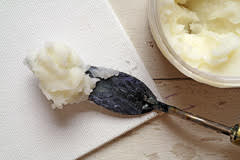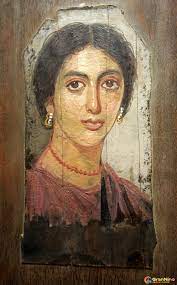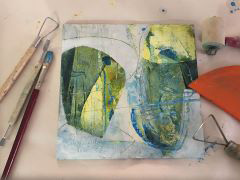| A Guide for Cold Wax |
 |
| Cold Wax is a soft buttery paste that consists of beeswax, solvent, and resin. It is used in painting, specifically oil painting, to help with many techniques. Cold wax can also be used with other mediums beside oil, such as alkyd oil colours, alkyd based painting mediums, and Gamsol. It also mixes well with other mediums such as dry pigment, powdered charcoal, marble dust, chalk pastel, graphite and oil sticks. Cold Wax is not physically cold or requires cold temperatures, the name refers to the fact that it requires no heat.
|
Pros and Cons
Listed below are the pros and cons of cold wax.
| Pros |
Cons |
| Speeds up drying time - as quick as within 24 hours!
Requires no special ventilation - unlike encaustic painting.
Makes oil paints thicker and matte - perfect for layering!
Adds body, transparency, and depth! |
Cannot be mixed with acrylic paint
Can be used as a varnish on top of an acrylic painting!
Has a melting point of 155F - needs to be kept in a cooler environment. |
|
| What is Cold Wax |
 |
| Cold Wax was created in the 1930s by Arthur Dove, an American artist. He did so by melting beeswax in turpentine and linseed oil. However it is derived from encaustic painting which has been around since the 4th century B.C, created by the Ancient Greeks. Pausias, a Greek painter of the 4th century B.C is said to have been one of the first recorded artists to use the encaustic painting methods.
Cold Wax is very similar to encaustic painting. Encaustic painting is also a wax medium that creates similar effects to that of cold wax. Encaustic painting builds up relief and gives the painting a rich optical effect creating a startlingly life-like illusion. This environmentally safe medium emits no toxic fumes and uses no solvents. The biggest difference between cold wax and encaustic painting is that encaustic painting must have the wax be molten to work with and then reheated once it is applied to the surface. Whereas with cold wax, no heating is required.
|

Cold Wax

Pausias Encaustic Painting
|
| How To Use Cold Wax |
 |
| Cold Wax paste has a very easy application process. All you have to do is mix the paste with the oil paint on your mixing palette. When mixing, you will need a ratio of 20% wax to 50% oil paint. The wax and oil paint mixture can be applied with an assortment of materials such as paint brushes, palette knives, colour pushers, squeegee, or rollers. It is best to apply the mixture to rather paper, canvas, or panel as it needs to be applied to an absorbent surface. Once applied, the wax then evaporates and hardens to the density of a beeswax candle. You can also remove cold wax with Gamsol. Cold Wax can also be used as a varnish, and does not just have to be used when mixed with paints. Instead wait for your painting to dry, and then rub a thin coat of the cold wax medium on top. This is a popular desired effect for acrylic paintings.
Cold Wax can add a number of things to your oil paintings! It helps speed up drying times and it increases the paint's workability. It also adds body, transparency, and depth to your artworks. Cold wax makes the oil colours thicker and dry with a more matte finish. When being used, cold wax and oil paint create a glazing effect with transparent layers being built up. After using cold wax, it will take about 24 hours to dry to a matte finish. However, if you would prefer a satin sheen finish, use a soft cotton cloth to buff out the cold wax after 4-6 hours. It's good to note that once the cold wax-oil paint mixture has dried, you can still continue to paint on top of it. Cold Wax paintings are best in cooler temperatures as they do have a melting point of 155 degrees F, therefore be careful where you store it.
|

Tools to use Cold Wax with

Cold Wax Techniques
|
| Overview |
 |
| Cold Wax is a wonderful medium to test out on your oil paintings! It's a simple, beginner friendly medium that only requires a small amount to be mixed into your paints. The results create beautiful matte finishes that enhance the body, transparency, and depth of your artworks. The fast drying times the wax creates are a huge bonus to your painting process as well! Using cold wax is definitely a technique to try out on your paintings.
|
| For more information! |
 |
|
If you have questions about any of our services or products, don't hesitate to contact us. Our knowledgeable staff is always happy to assist with answers, advice, or suggestions.
|
|

|



|
USA Giclee On Canvas, Fine Art Printing - Art Scanning & Reproductions - Handmade Oil Paintings - Custom Wood Panels, Metal Picture Framing - Block/Plaque Mountings, Large Format Dry Mounting & Lamination - Art Supplies: Stretcher Bars, Cradled Wood Panels and Artist Canvas - Collages On Canvas - Plexi/Acrylic Face Mounts - Block Acrylics, Fabric Printing, Dye Sublimation - Cityscape Skyline Prints, Resin, Photo Gifts and more...
|
|
© 2002-2025 - KeenART Media Ltd.
|
|
| |
|
